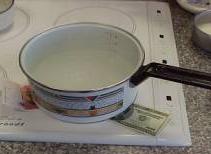I recently attended a homeshow where a manufacturer was doing a demo of induction cooktops. A pot of water was at a rolling boil and a twenty dollar bill was tucked between it and the cooking element. So that got my curiosity up! On another element, a pan of chocolate was being held at an ideal temperature for dipping strawberries. No bain marie or any special tools to keep the chocolate from scorching. Safety and control… every cook’s dream!

I have long been a “gas snob” because of the instant-on, instant off and range of control simply not available with electric cook-tops. I was also naive in thinking I would need to replace all of my cookware if I switched over to induction cooking. Wrong again. The prerequisite of induction cooking is cookware with ferrous content. Essentially, if a magnet will cling to a pot, it can be used on an induction cooktop.
Induction cooktops came out in the 1970s and have become very popular in Europe and only trending in North America recently. Control, cleanability, safety and energy efficiency is making them a popular choice for families of all stages.
Rather than relying on a flame as with gas ranges or electric elements or burners with electric stoves, an induction cooktop has a series of burners that create magnetic fields, which, in turn, induct or introduce a warming effect on ferrous pots and pans. The cooking vessels themselves heat and cook the food, not the components of the stove. The cooktop will feel warm after use, but will remain safe for the human skin to touch. When thinking of a home embracing universal design (safe and accessible for all abilities), induction cooktops have incredible potential. They would also potentially be much safer when placed in an island because of their very nature.
Spills are easily cleaned as they occur because one does not need to wait for the surface to cool before wiping down. Simply remove the pot and wipe the spill, then resume cooking! Similarly to a glass cooktop, they are easy to clean because there are no depressions to accumulate spills.
Induction cooktops are touted as being much more energy-efficient in their operation, but also consider that they heat the pots directly so you will have reduced cooling costs in the summer due to their reduced wasted energy.
Curious about induction but need more information? The GE appliance site has a wealth of information, as does The Induction Site.
Are you curious as to how much energy is used by many of your home appliances and electronics? This table from Toronto Hydro may be helpful. Or, if you want to be even more precise, use the energy calculator from the OEE to compare apples to apples when selecting appliances.
